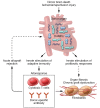Danger signals in regulating the immune response to solid organ transplantation
- PMID: 28530643
- PMCID: PMC5490743
- DOI: 10.1172/JCI90594
Danger signals in regulating the immune response to solid organ transplantation
Abstract
Endogenous danger signals, or damage-associated molecular patterns (DAMPs), are generated in response to cell stress and activate innate immunity to provide a pivotal mechanism by which an organism can respond to damaged self. Accumulating experimental and clinical data have established the importance of DAMPs, which signal through innate pattern recognition receptors (PRRs) or DAMP-specific receptors, in regulating the alloresponse to solid organ transplantation (SOT). Moreover, DAMPs may incite distinct downstream cellular responses that could specifically contribute to the development of allograft fibrosis and chronic graft dysfunction. A growing understanding of the role of DAMPs in directing the immune response to transplantation has suggested novel avenues for the treatment or prevention of allograft rejection that complement contemporary immunosuppression and could lead to improved outcomes for solid organ recipients.
Conflict of interest statement
Figures

References
Publication types
MeSH terms
Grants and funding
LinkOut - more resources
Full Text Sources
Other Literature Sources
Medical

